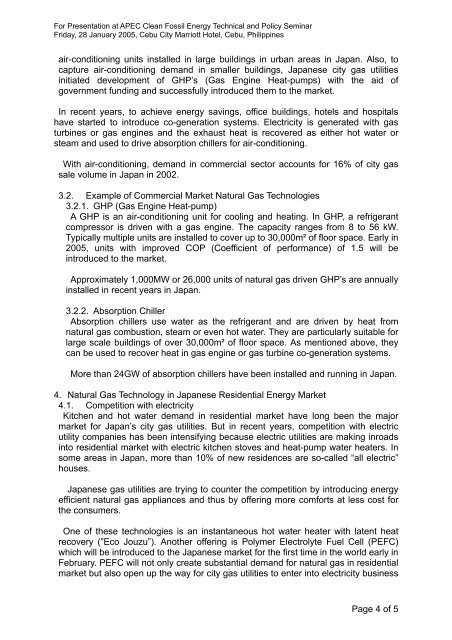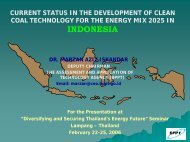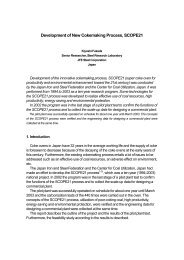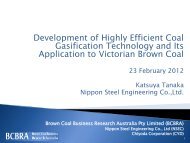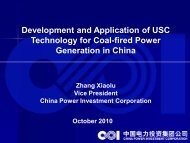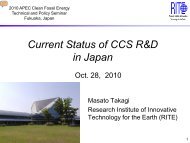Natural Gas Technologies and Markets: Japanese Experience
Natural Gas Technologies and Markets: Japanese Experience
Natural Gas Technologies and Markets: Japanese Experience
Create successful ePaper yourself
Turn your PDF publications into a flip-book with our unique Google optimized e-Paper software.
For Presentation at APEC Clean Fossil Energy Technical <strong>and</strong> Policy SeminarFriday, 28 January 2005, Cebu City Marriott Hotel, Cebu, Philippinesair-conditioning units installed in large buildings in urban areas in Japan. Also, tocapture air-conditioning dem<strong>and</strong> in smaller buildings, <strong>Japanese</strong> city gas utilitiesinitiated development of GHP’s (<strong>Gas</strong> Engine Heat-pumps) with the aid ofgovernment funding <strong>and</strong> successfully introduced them to the market.In recent years, to achieve energy savings, office buildings, hotels <strong>and</strong> hospitalshave started to introduce co-generation systems. Electricity is generated with gasturbines or gas engines <strong>and</strong> the exhaust heat is recovered as either hot water orsteam <strong>and</strong> used to drive absorption chillers for air-conditioning.With air-conditioning, dem<strong>and</strong> in commercial sector accounts for 16% of city gassale volume in Japan in 2002.3.2. Example of Commercial Market <strong>Natural</strong> <strong>Gas</strong> <strong>Technologies</strong>3.2.1. GHP (<strong>Gas</strong> Engine Heat-pump)A GHP is an air-conditioning unit for cooling <strong>and</strong> heating. In GHP, a refrigerantcompressor is driven with a gas engine. The capacity ranges from 8 to 56 kW.Typically multiple units are installed to cover up to 30,000m² of floor space. Early in2005, units with improved COP (Coefficient of performance) of 1.5 will beintroduced to the market.Approximately 1,000MW or 26,000 units of natural gas driven GHP’s are annuallyinstalled in recent years in Japan.3.2.2. Absorption ChillerAbsorption chillers use water as the refrigerant <strong>and</strong> are driven by heat fromnatural gas combustion, steam or even hot water. They are particularly suitable forlarge scale buildings of over 30,000m² of floor space. As mentioned above, theycan be used to recover heat in gas engine or gas turbine co-generation systems.More than 24GW of absorption chillers have been installed <strong>and</strong> running in Japan.4. <strong>Natural</strong> <strong>Gas</strong> Technology in <strong>Japanese</strong> Residential Energy Market4.1. Competition with electricityKitchen <strong>and</strong> hot water dem<strong>and</strong> in residential market have long been the majormarket for Japan’s city gas utilities. But in recent years, competition with electricutility companies has been intensifying because electric utilities are making inroadsinto residential market with electric kitchen stoves <strong>and</strong> heat-pump water heaters. Insome areas in Japan, more than 10% of new residences are so-called “all electric”houses.<strong>Japanese</strong> gas utilities are trying to counter the competition by introducing energyefficient natural gas appliances <strong>and</strong> thus by offering more comforts at less cost forthe consumers.One of these technologies is an instantaneous hot water heater with latent heatrecovery (”Eco Jouzu”). Another offering is Polymer Electrolyte Fuel Cell (PEFC)which will be introduced to the <strong>Japanese</strong> market for the first time in the world early inFebruary. PEFC will not only create substantial dem<strong>and</strong> for natural gas in residentialmarket but also open up the way for city gas utilities to enter into electricity businessPage 4 of 5


